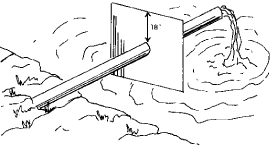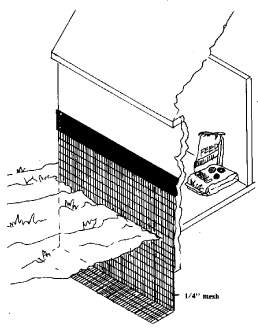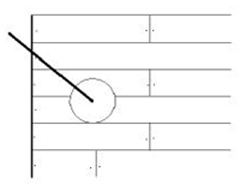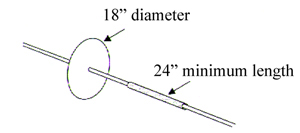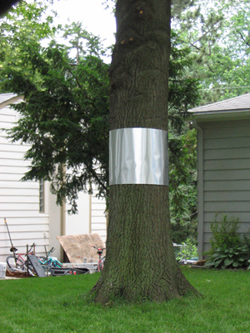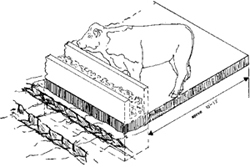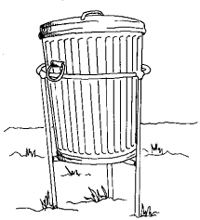G2017
Rodent-Proof Construction:
Drains and Feeding Equipment
Use of common-sense construction techniques involving drains and feeding equipment can effectively prevent or reduce damage by rats and mice.
Stephen M. Vantassel, Extension Wildlife Damage Project Coordinator
Scott E. Hygnstrom, Extension Specialist, Wildlife Damage
Dennis M. Ferraro, Extension Educator
- Physical Capabilities of Rats and Mice
- Drains and Pipes
- Mechanical Guards
- Livestock Feed Bunks and Bins
- Feed and Refuse Storage
- Acknowledgments
Comprehensive rodent-proofing must include protective devices on pipes, electrical cables and conduits, drains, and other equipment where rodents travel. In addition to preventing access to buildings along these routes, attention must be given to reducing sources of food, water, and shelter used by rats and mice. This NebGuide focuses on the exclusion of Norway rats (Rattus norvegicus) and house mice (Mus musculus), but the information is applicable for a variety of rodents and birds. More methods to make structures rodent-proof are described in NebGuide G1530, Rodent-Proof Construction: Structural, http://www.ianrpubs.unl.edu/sendIt/g1530.pdf.
Physical Capabilities of Rats and Mice
To help identify how rodents can enter a structure, their capabilities must be understood. For example, rats and mice can:
- run along and climb electrical wires, ropes, cables, vines, shrubs, and trees to gain entry to buildings;
- climb almost any rough vertical surface such as wood, brick, concrete, and weathered sheet metal;
- crawl horizontally along pipes, augers, conveyors, and conduit; and
- gnaw through a variety of materials, including aluminum sheeting, wood, rubber, vinyl, plastic, and concrete block.
In addition, rats can:
- climb the outside of vertical pipes and conduit up to 3 inches in diameter, climb the outside of larger pipes attached to buildings by bracing themselves against a wall, and climb the inside of 1½- to 4-inch vertical pipes;
- scale any horizontal or vertical wire;
- travel on any horizontal pipe;
- jump 36 inches vertically and 48 inches horizontally;
- drop 50 feet without serious injury;
- burrow straight down into the ground to a depth of 48 inches;
- enter openings slightly larger than ½ inch in diameter;
- reach up to 13 inches along vertical walls; and
- swim half a mile in open water, dive through water traps in plumbing, and travel in sewer lines against substantial current.
|
House mice can:
- jump up 18 inches vertically, and jump up against a vertical surface to reach even higher;
- drop 8 feet and scurry away unharmed;
- enter openings slightly larger than ¼-inch in diameter;
- travel up to 1½ miles; and
- hang upside down and travel some distance on ¼-inch wire mesh or 12-gauge wire.
Drains and Pipes
Both rats and mice use drainage pipes or sewage systems as routes to enter buildings. Equip floor drains with metal grates fastened securely in place. Use grate openings that are ¼ inch across or less and made from 19-gauge wire. Although uncommon, rats can enter buildings through toilet plumbing. Unfortunately, the product that prevents rat entry through toilets, called a rat guard, is no longer available. People experiencing this problem should consult with their local sanitation or health department about initiating a rat control program in the sewer system.
|
Those with onsite wastewater treatment systems such as a septic tank/drainfield system or residential lagoon should contact a certified professional in the onsite industry. If using an onsite wastewater treatment system, secure the discharge pipe to a residential lagoon underwater, near the center of the lagoon, as required to prevent entry of rodents. Avoid holes in covers of septic system cleanouts or risers to eliminate potential entry points.
Manure management systems in livestock facilities may be of a type in which manure or water is periodically drained from the building to a lagoon or other storage area. Extend discharge pipes far enough over the bank or into the lagoon to prevent rodents from jumping or crawling into the open end. Install rodent shields (Figure 1), or use a downward-turned elbow to prevent rodents from gaining access.
A “floating” metal cover at the open end of the discharge pipe with a hinge at its upper edge, also can be effective. The hinge must operate easily so water or manure will open the cover, but the cover must fall back into the closed position when the flow stops. These covers sometimes freeze shut, or solids may prop them open, so check them regularly.
Always cap pump-out ports for manure storage pits when not in use. Left open, they allow easy entry to rodents.
Mechanical Guards
Install guards made of sheet metal or similar materials to prevent rodents from climbing or traveling along a particular route. Guards must be wide enough and positioned appropriately to keep rodents from climbing over or jumping around them.
Attach sheet metal bands to walls to prevent climbing by rodents. Rodent guards should be 12 to 18 inches wide and 36 inches above the floor or ground level. They can be installed to prevent rodents from climbing the outside of buildings that have rough exterior walls. Use rodent guards in combination with hardware cloth, or other suitable materials, to rodent-proof corn cribs, bins, and other buildings (Figure 2).
Install guards to prevent rodents from traveling along horizontal or vertical pipes (Figure 3a), wires (Figures 3b,c), conduit, and cables abutting a structure.
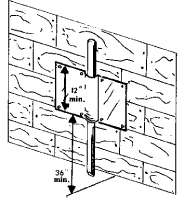 |
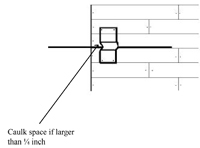 |
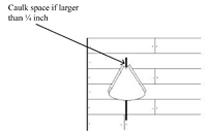 |
||
| Figure 3a. Install a 12-inch-square piece of aluminum flashing or galvanized metal around conduit pipe to prevent rodents from climbing. Caulk gap around pipe if opening is larger than ¼ inch. | Figure 3b. Flat rat guard for small pipes and wires is made of 26-gauge or heavier galvanized sheet steel. Minimum width — 24 inches. 18 inches from wire to top of guard, 12 inches from wire to bottom of guard. | Figure 3c. Triangle guard made of aluminum flashing or galvanized metal to prevent rodents from climbing. Triangle should be 12 inches wide at the base and 12 inches in height. Figures 3b,c courtesy of National Park Service. |
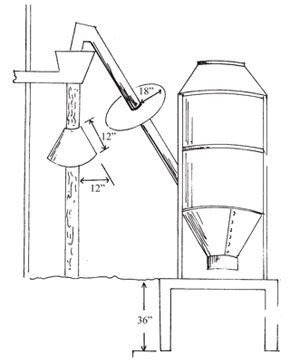 |
|
||||||
| Figure 4. Guards prevent rats from climbing augers, pipes, or wires leading to buildings. Free-hanging guards are easily damaged. Construct circular guards of 24-gauge sheet metal and anchor them in place by one or more arms on the side opposite to that accessible to rats. Circular guards must extend out 18 inches all around the lines they guard. Cone-shaped circular guards prevent rats from climbing vertical pipes, pilings, and trees. Footings or foundations for grain bins should extend into the ground to prevent rat burrowing. |
|
Caulk gaps between the wire or pipe and the guard. Install cones or discs on suspended cables, ropes, augers, or pipes (Figure 4).
Use shields or wire guards made of ¼-inch wire mesh to exclude rodents from the interior of feed augers, fan housings, and similar openings. With some ingenuity, you can design rodent guards to fit any situation.
Prevent rats from walking on cables by purchasing disc baffles and pipe sleeves that are available to prevent squirrels from using utility lines (Figures 5a,b). Consult with your utility company before installing any of these products yourself. Under no circumstances should electrical lines be approached. Have the utility company install them.
Power companies have successfully used a product called CritterGuard® to keep rodents from running on their lines.
To protect nonelectrical bearing horizontal lines, cut a 2-inch diameter plastic pipe lengthwise, spread it open, and place it over the cable. The sleeves should fit loosely so they rotate as rats try to traverse them. Sleeves should be at least 18 to 24 inches long.
Collars can be creatively painted so that they blend in with the background. Use metal collars to encircle trees and poles to prevent travel by rodents (Figure 6). Collars should be at least 2 feet wide and placed 6 to 8 feet above the ground. Overlap collar edges and connect by springs to allow for tree growth or to be enlarged on a biannual basis.
Livestock Feed Bunks and Bins
Rats often burrow and nest under feed bunks that are placed directly on the ground, on concrete blocks, or near ground level. Install properly designed concrete bunks that sit solidly on concrete aprons to eliminate rodent habitat (Figure 7). Though traffic by livestock may discourage rats from burrowing under aprons, you may need to build a foundation to prevent burrowing around the sides of the aprons not accessible to livestock.
Concrete foundations for feed bins should extend 36 inches below grade at the outer edges to prevent rats from burrowing under slabs (Figure 6). Install 1½ inches of 1-inch diameter creek gravel and maintain a clean, weed-free zone around slab perimeters to discourage rats from burrowing, and to permit easier detection of rat activity. A less expensive but effective alternative consists of pouring 2 inches of packed gravel on top of a layer of ½-inch galvanized hardware cloth. The hardware cloth will prevent burrowing even if the rats decide to dig through the packed gravel.
Feed and Refuse Storage
Properly storing and disposing of household garbage, waste grain or livestock feed, and dead animals are very important parts of rat control. Good sanitation limits sources of food, water, and shelter for rodents. Whenever possible, store livestock or pet feed in secure containers with tight-fitting lids or similar rodent-proof or resistant containers (Figure 8). Sweep areas where spilled grain and feed can accumulate, such as around augers, bins, and feed bunks. Bury carcasses at least 24 inches below the ground surface to discourage scavenging.
For additional information on rodent control, see NebGuide G1737, Controlling Rats, http://www.ianrpubs.unl.edu/sendIt/g1737.pdf and NebGuide G1105, Controlling House Mice, http://www.ianrpubs.unl.edu/sendIt/g1105.pdf.
Acknowledgments
Dallas R. Virchow, Extension Assistant-Wildlife Damage, contributed to an earlier edition of this NebGuide. We would like to thank the U.S. National Park Service for its contribution to this publication.
This publication has been peer reviewed.
Disclaimer Reference to commercial products or trade names is made with the understanding that no discrimination is intended of those not mentioned and no endorsement by University of Nebraska–Lincoln Extension is implied for those mentioned. |
Visit the University of Nebraska–Lincoln Extension Publications Web site for more publications.
Index: Wildlife Management
Wildlife Damage Control
Issued May 2010
